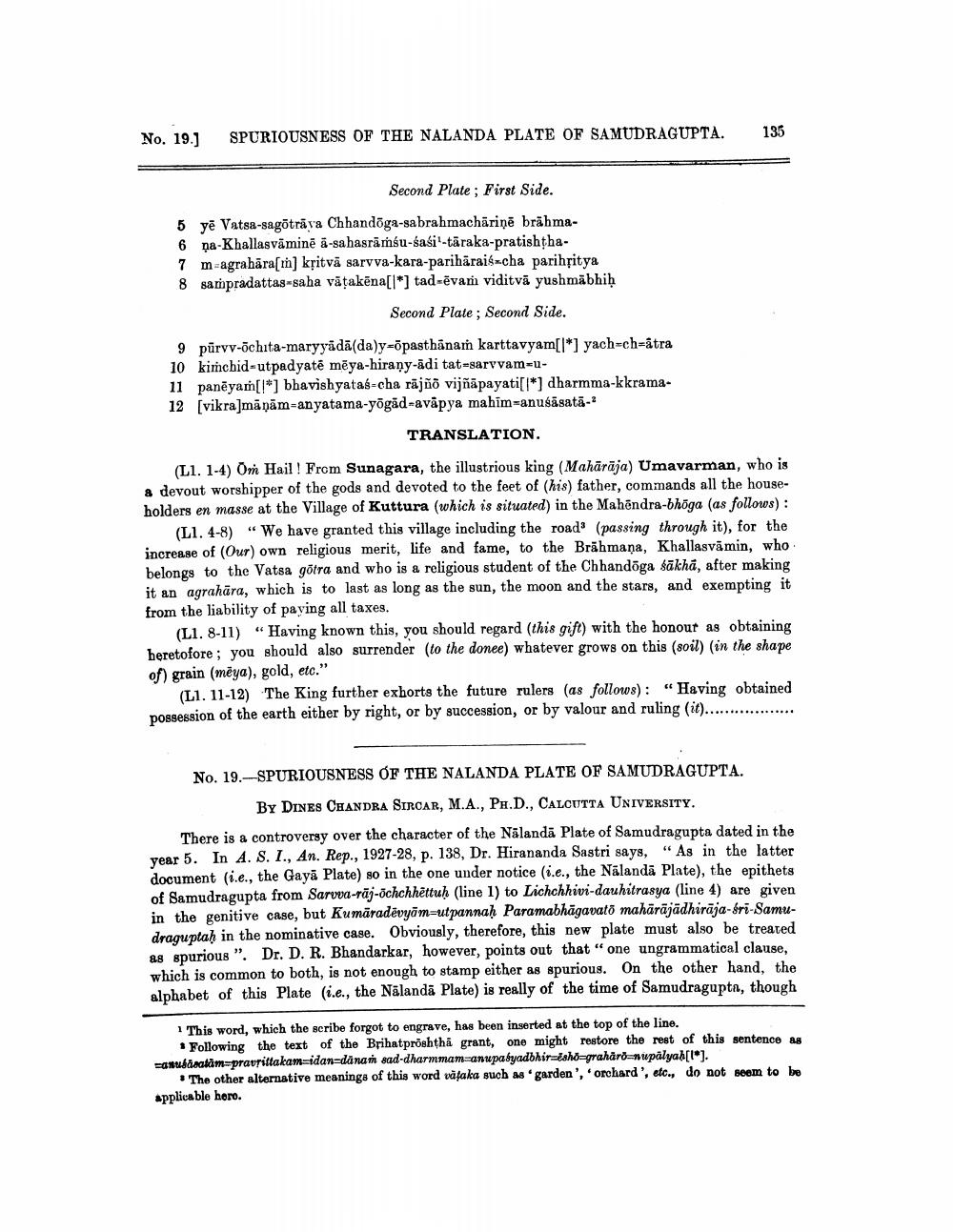________________
No. 19.)
SPURIOUSNESS OF THE NALANDA PLATE OF SAMUDRAGUPTA.
135
Second Plate; First Side. 5 yē Vatsa-sagātrāva Chhandöga-sabrahmachāriņē brāhma6 na-Khallasväminē ā-sahasrāmśu-sasi -tāraka-pratishtha7 m agrahāra[m] kritvā sarvva-kara-parihäraischa parihsitya 8 sampradattas-saha vățakēna[l*] tad-evan viditvā yushmäbhiḥ
Second Plate ; Second Side.
9 pūrvv-ochita-maryyādā(da)y=āpasthānam karttavyam[l*) yach=ch=ātra 10 kimchid-utpadyatē mēya-hirany-adi tat-garvvam=11 panēyam[*] bhavishyatas-cha rājño vijñāpayati[l*) dharmma-kkrama12 [vikra]māņām-anyatama-yogād=avāpya mahim-anusäsata.
TRANSLATION.
(L1. 1-4) Om Hail! From Sunagara, the illustrious king (Mahārāja) Umavarman, who is & devout worshipper of the gods and devoted to the feet of (his) father, commands all the householders en masse at the Village of Kuttura (which is situated) in the Mahendra-bhöga (as follows) :
(L1. 4-8) “We have granted this village including the road' (passing through it), for the increase of (Our) own religious merit, life and fame, to the Brāhmana, Khallasvämin, who belongs to the Vatsa götra and who is a religious student of the Chhandöga sākhă, after making it an agrahāra, which is to last as long as the sun, the moon and the stars, and exempting it from the liability of paying all taxes.
(L1. 8-11) “Having known this, you should regard (this gift) with the honour as obtaining beretofore; you should also surrender to the donee) whatever grows on this (soil) (in the shape of) grain (mēya), gold, etc."
(L1. 11-12) The King further exhorts the future rulers (as follows): "Having obtained possession of the earth either by right, or by succession, or by valour and ruling (it)............
No. 19.–SPURIOUSNESS OF THE NALANDA PLATE OF SAMUDRAGUPTA.
BY DINES CHANDRA SIRCAR, M.A., Ph.D., CALCUTTA UNIVERSITY. There is a controversy over the character of the Nalandā Plate of Samudragupta dated in the year 5. In A. S. I., An. Rep., 1927-28, p. 138, Dr. Hirananda Sastri says, "As in the latter document (i.e., the Gayā Plate) so in the one under notice (i.e., the Nālandā Plate), the epithets of Samudragupta from Sarva-raj-ochchhēttuh (line 1) to Lichchhivi-dauhitrasya (line 4) are given in the genitive case, but Kumāradevyām-utpannah Paramabhāgavató mahārājādhiraja-Sri-Samudraguptah in the nominative case. Obviously, therefore, this new plate must also be treated as spurious". Dr. D. R. Bhandarkar, however, points out that “one ungrammatical clause, which is common to both, is not enough to stamp either as spurious. On the other hand, the alphabet of this Plate (i.e., the Nālandā Plate) is really of the time of Samudraguptn, though
1 This word, which the scribe forgot to engrave, has been inserted at the top of the line.
Following the text of the Brihatproshtha grant, one might restore the rest of this sentence as asubasatam-pravrittakamsidan-danam sad-dharmmam-anupabyadbhiralahograharo-nupälyah[l*].
• The other alternative meanings of this word văţaka such as "garden', orchard', etc., do not seem to be applicable horo.




